回民街英文介绍
- 格式:doc
- 大小:34.00 KB
- 文档页数:3
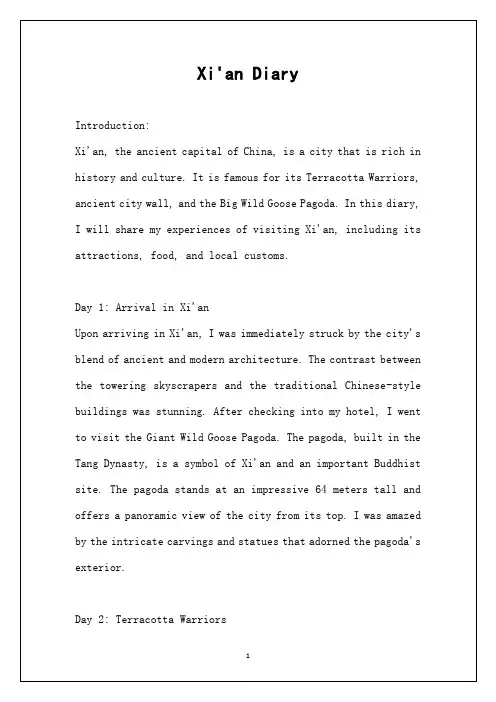
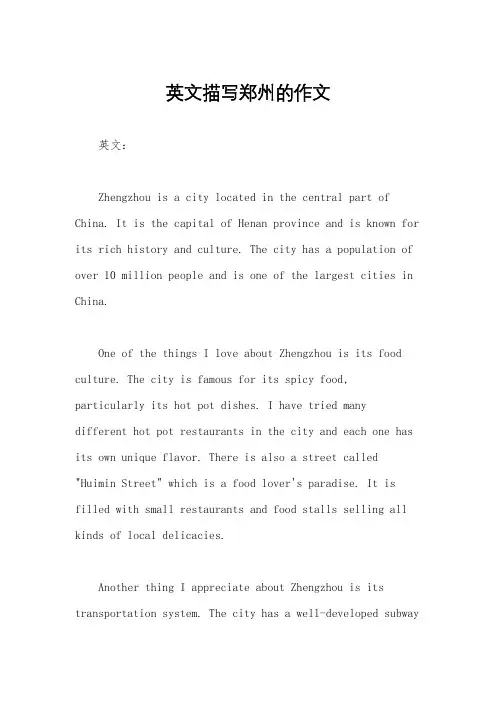
英文描写郑州的作文英文:Zhengzhou is a city located in the central part of China. It is the capital of Henan province and is known for its rich history and culture. The city has a population of over 10 million people and is one of the largest cities in China.One of the things I love about Zhengzhou is its food culture. The city is famous for its spicy food,particularly its hot pot dishes. I have tried manydifferent hot pot restaurants in the city and each one has its own unique flavor. There is also a street called "Huimin Street" which is a food lover's paradise. It is filled with small restaurants and food stalls selling all kinds of local delicacies.Another thing I appreciate about Zhengzhou is its transportation system. The city has a well-developed subwaysystem that makes it easy to get around. I can easilytravel to different parts of the city without having to worry about traffic or parking. The buses are also convenient and affordable.Zhengzhou is also a city with a rich history. There are many historical sites and cultural landmarks to visit. One of my favorites is the Shaolin Temple, which is locatedjust outside of the city. It is a famous Buddhist temple and is known for its martial arts tradition.中文:郑州是中国中部的一座城市,是河南省的省会,以其丰富的历史和文化而闻名。
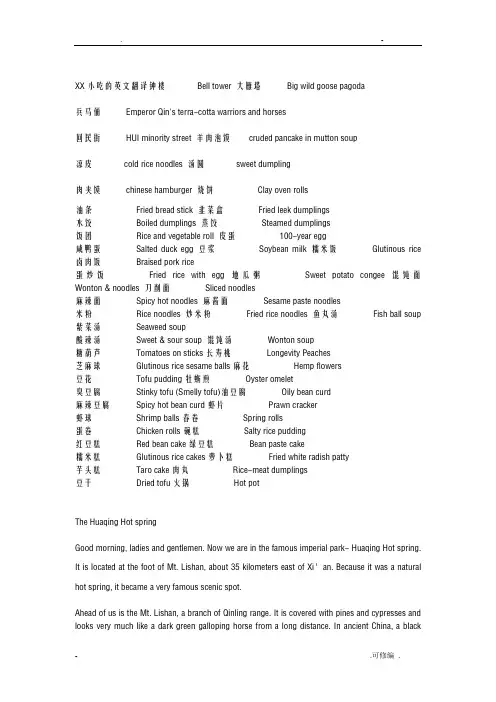
XX小吃的英文翻译钟楼Bell tower 大雁塔Big wild goose pagoda兵马俑Emperor Qin's terra-cotta warriors and horses回民街HUI minority street 羊肉泡馍cruded pancake in mutton soup凉皮cold rice noodles 汤圆sweet dumpling肉夹馍chinese hamburger 烧饼Clay oven rolls油条Fried bread stick 韭菜盒Fried leek dumplings水饺Boiled dumplings 蒸饺Steamed dumplings饭团Rice and vegetable roll 皮蛋100-year egg咸鸭蛋Salted duck egg 豆浆Soybean milk 糯米饭Glutinous rice 卤肉饭Braised pork rice蛋炒饭Fried rice with egg 地瓜粥Sweet potato congee 馄饨面Wonton & noodles 刀削面Sliced noodles麻辣面Spicy hot noodles 麻酱面Sesame paste noodles米粉Rice noodles 炒米粉Fried rice noodles 鱼丸汤Fish ball soup 紫菜汤Seaweed soup酸辣汤Sweet & sour soup 馄饨汤Wonton soup糖葫芦Tomatoes on sticks长寿桃Longevity Peaches芝麻球Glutinous rice sesame balls麻花Hemp flowers豆花Tofu pudding牡蛎煎Oyster omelet臭豆腐Stinky tofu (Smelly tofu)油豆腐Oily bean curd麻辣豆腐Spicy hot bean curd虾片Prawn cracker虾球Shrimp balls春卷Spring rolls蛋卷Chicken rolls碗糕Salty rice pudding红豆糕Red bean cake绿豆糕Bean paste cake糯米糕Glutinous rice cakes萝卜糕Fried white radish patty芋头糕Taro cake肉丸Rice-meat dumplings豆干Dried tofu火锅Hot potThe Huaqing Hot springGood morning, ladies and gentlemen. Now we are in the famous imperial park- Huaqing Hot spring. It is located at the foot of Mt. Lishan, about 35 kilometers east of Xi’an. Because it was a natural hot spring, it became a very famous scenic spot.Ahead of us is the Mt. Lishan, a branch of Qinling range. It is covered with pines and cypresses and looks very much like a dark green galloping horse from a long distance. In ancient China, a blackhorse was called “Li”, and this is how it got its name- Li shan mountain.Have you noticed the little tower on the top of this hill? This is the famous Remains of a beacon tower from the western Zhou dynasty over 3000 years ago. There are two famous sayings relatedwith it: “a single smile costs 1000 pieces of gold” and “the sovereign rulers are fooled by the beacon fire”.Well, let’s e back to the Huaqing Hot spring. Historically, during the western Zhou Dynasty, a stonepool was built and was given the name of Li shan tang. The site was enlarged into a bigger palace during the Han Dynasty, and was renamed Li Palace. During the Tang Dynasty, Emperor Xuanzong had a walled palace built around the Li Hill. It was known as Huaqing Place.As we know, the Huaqing Hall was destroyed at the end of the Tang dynasty, and what is open to the public today, was rebuilt afterwards according to the Tang dynasty style on the original site. You see all the construction here was rebuilt in 1959, so it looks new.Entering from the west gate ,we see the nine dragon pool.In front of it is the frost flying hall. In Tang dynasty , emperor Xuan Zong and his favorite concubine lady Yang used to make their home heresince it was cold in the capital Chang’an . It was said that the steam went straight up, when it metthe cold air, it turned into frost. Then you can see the frost flying in the wind very beautiful. Therefore, it got its name---the frost flying Hall.Now let’s look at the second part-Huaqing Imperial pool museum which was discovered in April, 1982. As you see, the ruins of the 5 imperial pools are the Crabapple pool, the Lotus flower Pool, the Shang Shi Pool the Crown Prince Pool and the Star Pool. The Crabapple Pool was the private bathing pool for lady Yang herself. And the lotus flower pool was the private bathing pool for emperor XuanZong himself. Shangshi Pool, was the public bathing pool for the high ranking officials in the court. As for the Star Pool, it was said that emperor Tai zong, liked to bath here very much. The spring water contains lots of minerals, which makes it suitable for bathing and is helpful for curing some diseases. So people all like it very much and maybe this is the reason why many rulers chose this place as a capital in winters.Huaqing Hot Spring is not only famous for its ancient history, but also for its modern history.Now please follow me to the five-room hall where the Xi’an Incident took place. The Xi’an incident happened on December 12, 1936, the two great generals, Zhang xueliang and Yang hucheng, took armed remonstrance to force jiang jieshi , China Nationalist’s leader,to fight against the Japanese invaders when China was in danger. This is the famous Xi’an incidents.In the third room Hall, youcan also see some pictures and the contemporary newspapers ,they well described the details about the Xi’an Incident.Please look at that pavilion halfway up Li Hill. That was built by one of Chiang’s favorite generals in order to memorate this incident. Originally, this pavilion was named Justice Pavilion. After 1949, it was renamed Catching-Chiang Pavilion. Now it has the name “the Remonstration Pavilion”. Ironchains and rings are available all the way up to the crevice east of the pavilion by which visitors can climb up and take a look at his shelter.After visiting the five room hall, here we are in the Pear garden. This is the birthplace of Chinese operas. Over 1300 years ago, emperor xuanzong-the great musician and Lady Yang---the great dancer established Jiao Fang---the imperial music and dance school right here. They not only taught the boys and girls music and dance , but also posed music and practiced dances bythemselves. It’s so beautiful and elegant that even today it’s still popular for young and old, menand women. Emperor Xuanzong and Lady Yang were greatly devoted to Chinese music and dance.Tonight, you will enjoy some music and dances they created at that time---the recreatedTang Dynasty Show. I’m sure you will enjoy urself very much.Ok, ladies and gentlemen. So much for the Huaqing Hot spring Palace. Next, it’s your time.you canwalk around and take some pictures. Enjoy yourself and watch the step please. Thank you for listening.~女士们、先生们:大家好!现在我们来到了著名的皇家园林——华清池。
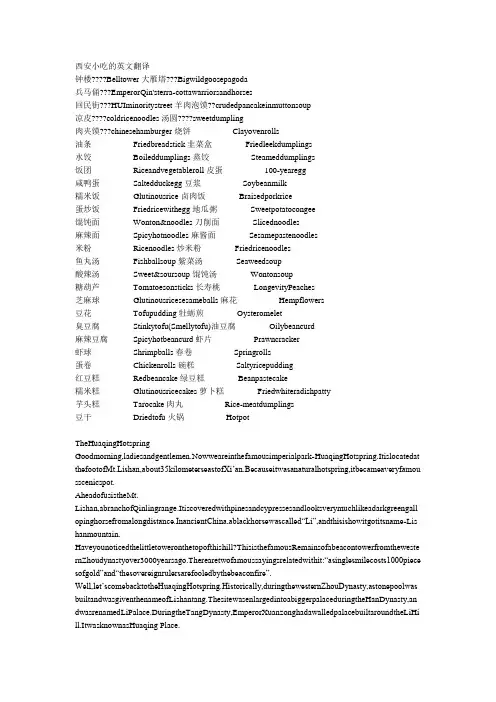
西安小吃的英文翻译钟楼????Belltower大雁塔???Bigwildgoosepagoda兵马俑???EmperorQin'sterra-cottawarriorsandhorses回民街???HUIminoritystreet羊肉泡馍??crudedpancakeinmuttonsoup凉皮????coldricenoodles汤圆????sweetdumpling肉夹馍???chinesehamburger烧饼Clayovenrolls油条Friedbreadstick韭菜盒Friedleekdumplings水饺Boileddumplings蒸饺Steameddumplings饭团Riceandvegetableroll皮蛋100-yearegg咸鸭蛋Saltedduckegg豆浆Soybeanmilk糯米饭Glutinousrice卤肉饭Braisedporkrice蛋炒饭Friedricewithegg地瓜粥Sweetpotatocongee馄饨面Wonton&noodles刀削面Slicednoodles麻辣面Spicyhotnoodles麻酱面Sesamepastenoodles米粉Ricenoodles炒米粉Friedricenoodles鱼丸汤Fishballsoup紫菜汤Seaweedsoup酸辣汤Sweet&soursoup馄饨汤Wontonsoup糖葫芦Tomatoesonsticks长寿桃LongevityPeaches芝麻球Glutinousricesesameballs麻花Hempflowers豆花Tofupudding牡蛎煎Oysteromelet臭豆腐Stinkytofu(Smellytofu)油豆腐Oilybeancurd麻辣豆腐Spicyhotbeancurd虾片Prawncracker虾球Shrimpballs春卷Springrolls蛋卷Chickenrolls碗糕Saltyricepudding红豆糕Redbeancake绿豆糕Beanpastecake糯米糕Glutinousricecakes萝卜糕Friedwhiteradishpatty芋头糕Tarocake肉丸Rice-meatdumplings豆干Driedtofu火锅HotpotTheHuaqingHotspringGoodmorning,ladiesandgentlemen.Nowweareinthefamousimperialpark-HuaqingHotspring.Itislocatedat thefootofMt.Lishan,about35kilometerseastofXi’an.Becauseitwasanaturalhotspring,itbecameaveryfamou sscenicspot.AheadofusistheMt.Lishan,abranchofQinlingrange.Itiscoveredwithpinesandcypressesandlooksverymuchlikeadarkgreengall opinghorsef romalongdistance.InancientChina,ablackhorsewascalled“Li”,andthisishowitgotitsname-Lis hanmountain.Haveyounoticedthelittletoweronthetopofthishill?ThisisthefamousRemainsofabeacontowerfromtheweste rnZhoudynastyover3000yearsago.Therearetwofamoussayingsrelatedwi thit:“asinglesmilecosts1000piece sofgold”and“thesovereignrulersarefooledbythebeaconfire”.Well,let’scomebacktotheHuaqingHotspring.Historically,duringthewesternZhouDynasty,astonepoolwas builtandwasgiventhenameofLishantang.ThesitewasenlargedintoabiggerpalaceduringtheHanDynasty,an dwasrenamedLiPalace.DuringtheTangDynasty,EmperorXuanzonghadawalledpalacebuiltaroundtheLiHi ll.ItwasknownasHuaqing Place.Asweknow,theHuaqingHallwasdestroyedattheendoftheTangdynasty,andwhatisopentothepublictoday,w asrebuiltafterwardsaccordingtotheTangdynastystyleontheoriginalsite.Youseealltheconstructionherewasr ebuiltin1959,soitlooksnew.Enteringfromthewestgate,weseetheninedragonpool.Infrontofitisthefrostflyinghall.InTangdynasty,emper orXuanZongandhisfavoriteconcubineladyYangusedtomaketheirhomeheresinceitwascoldinthecapitalCh ang’an.Itwassaidthatthesteamwentstraightup,whenitmetthecoldair,itturnedintofrost.Thenyoucanseethefr ostflyinginthewindverybeautiful.Therefore,itgotitsname---thefrostflyingHall.Nowlet’slookatthesecondpart-HuaqingImperialpoolmuseumwhichwasdiscoveredinApril,1982.Asyousee,theruinsofthe5imperialpools aretheCrabapplepool,theLotusflowerPool,theShangShiPooltheCrownPrincePoolandtheStarPool.TheCra bapplePoolwastheprivatebathingpoolforladyYangherself.Andthelotusflowerpoolwastheprivatebathingp oolforemperorXuanZonghimself.ShangshiPool,wasthepublicbathingpoolforthehighrankingofficialsinth ecourt.AsfortheStarPool,itwassaidthatemperorTaizong,likedtobathhereverymuch.Thespringwatercontai nslotsofminerals,whichmakesitsuitableforbathingandishelpfulforcuringsomediseases.Sopeoplealllikeitv erymuchandmaybethisisthereasonwhymanyrulerschosethisplaceasacapitalinwinters. HuaqingHotSpringisnotonlyfamousforitsancienthistory,butalsoforitsmodernhistory.Nowpleasefollowm etothefive-roomhallwheretheXi’anIncidenttookplace.TheXi’anincidenthappenedonDecember12,1936,t hetwogreatgenerals,ZhangxueliangandYanghucheng,tookarmedremonstrancetoforcejiangjieshi,ChinaN ationalist’sleader,tofightagainsttheJapaneseinvaderswhenChinawasindanger.ThisisthefamousXi’anincid ents.InthethirdroomHall,youcanalsoseesomepicturesandthecontemporarynewspapers,theywelldescribed thedetailsabouttheXi’anIncident.PleaselookatthatpavilionhalfwayupLiHill.ThatwasbuiltbyoneofChiang’sfavoritegeneralsinordertocomm emoratethisincident.Originally,thispavilionwasnamedJusticePavilion.After1949,itwasrenamedCatching -ChiangPavilion.Nowithasthename“theRemonstrationPavilion”.Ironchainsandringsareavailableallthewa yuptothecreviceeastofthepavilionbywhichvisitorscanclimbupandtakealookathisshelter. Aftervisitingthefiveroomhall,hereweareinthePeargarden.ThisisthebirthplaceofChineseoperas.Over1300 yearsago,emperorxuanzong-thegreatmusicianandLadyYang---thegreatdancerestablishedJiaoFang---thei mperialmusicanddanceschoolrighthere.Theynotonlytaughttheboysandgirlsmusicanddance,butalsocomp osedmusicandpracticeddancesbythemselves.It’ssobeautifulandelegantthateventodayit’sstillpopularforyo ungandold,menandwomen.EmperorXuanzongandLadyYangweregreatlydevotedtoChinesemusicanddan ce.Tonight,youwillenjoysomemusicanddancestheycreatedatthattime---therecreatedTangDynastyShow.I ’msureyouwillenjoyurselfverymuch.Ok,ladiesandgentlemen.SomuchfortheHuaqingHotspringPalace.Next,it’syourtime.youcanwalkaroundan dtakesomepictures.Enjoyyourselfandwatchthestepplease.Thankyouforlistening.~女士们、先生们:大家好!现在我们来到了着名的皇家园林——华清池。
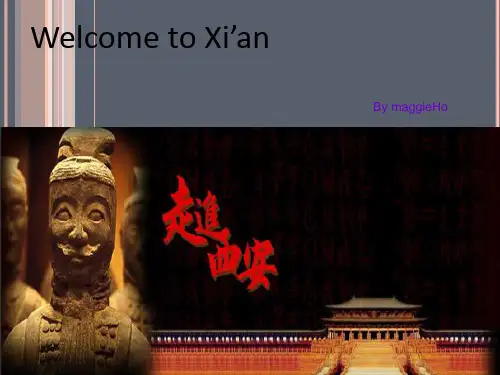
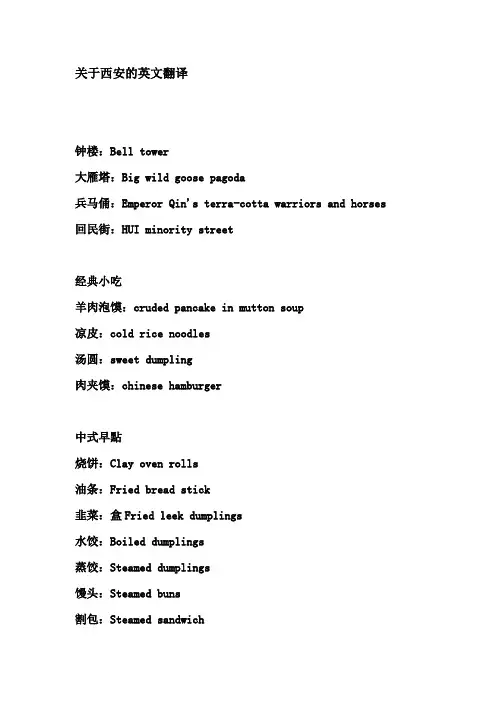
关于西安的英文翻译钟楼:Bell tower大雁塔:Big wild goose pagoda兵马俑:Emperor Qin's terra-cotta warriors and horses 回民街:HUI minority street经典小吃羊肉泡馍:cruded pancake in mutton soup凉皮:cold rice noodles汤圆:sweet dumpling肉夹馍:chinese hamburger中式早點烧饼:Clay oven rolls油条:Fried bread stick韭菜:盒Fried leek dumplings水饺:Boiled dumplings蒸饺:Steamed dumplings馒头:Steamed buns割包:Steamed sandwich饭团:Rice and vegetable roll 蛋饼:Egg cakes皮蛋:100-year egg咸鸭蛋:Salted duck egg豆浆:Soybean milk饭类稀饭:Rice porridge白饭:Plain white rice油饭:Glutinous oil rice糯米饭:Glutinous rice卤肉饭:Braised pork rice蛋炒饭:Fried rice with egg 地瓜粥:Sweet potato congee面类馄饨面:Wonton & noodles刀削面:Sliced noodles麻辣面:Spicy hot noodles麻酱面:Sesame paste noodles 鴨肉面:Duck with noodles鱔魚面:Eel noodles乌龙面:Seafood noodles榨菜肉丝面:Pork , pickled mustard green noodles 牡蛎细面:Oyster thin noodles板条:Flat noodles米粉:Rice noodles炒米粉:Fried rice noodles冬粉:Green bean noodle汤类鱼丸汤:Fish ball soup貢丸汤:Meat ball soup蛋花汤:Egg & vegetable soup蛤蜊汤:Clams soup牡蛎汤:Oyster soup紫菜汤:Seaweed soup酸辣汤:Sweet & sour soup馄饨汤:Wonton soup猪肠汤:Pork intestine soup甜点爱玉:Vegetarian gelatin糖葫芦:Tomatoes on sticks长寿桃:Longevity Peaches芝麻球:Glutinous rice sesame balls 麻花:Hemp flowers双胞胎:Horse hooves冰类绵绵冰:Mein mein ice麦角冰:Oatmeal ice地瓜冰:Sweet potato ice紅豆牛奶冰:Red bean with milk ice 八宝冰:Eight treasures ice豆花:Tofu pudding果汁甘蔗汁:Sugar cane juice酸梅汁:Plum juice杨桃汁:Star fruit juice青草茶:Herb juice牡蛎煎:Oyster omelet臭豆腐:Stinky tofu (Smelly tofu) 油豆腐:Oily bean curd麻辣豆腐:Spicy hot bean curd虾片:Prawn cracker虾球:Shrimp balls春卷:Spring rolls蛋卷:Chicken rolls碗糕:Salty rice pudding筒仔米糕:Rice tube pudding红豆糕:Red bean cake绿豆糕:Bean paste cake糯米糕:Glutinous rice cakes萝卜糕:Fried white radish patty 芋头糕:Taro cake肉圆:Taiwanese Meatballs水晶饺:Pyramid dumplings肉丸:Rice-meat dumplings豆干:Dried tofu当归鸭:Angelica duck槟榔:Betel nut火锅:Hot pot肉羹汤:Pork thick soup 鱿鱼汤:Squid soup花枝羹:Squid thick soup。
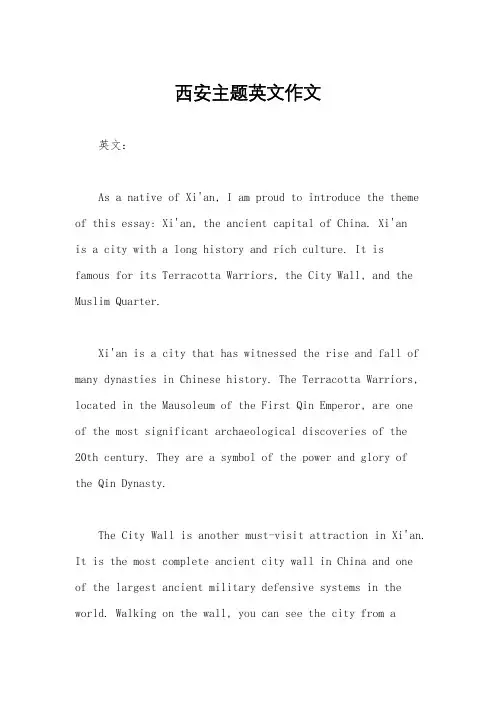
西安主题英文作文英文:As a native of Xi'an, I am proud to introduce the theme of this essay: Xi'an, the ancient capital of China. Xi'anis a city with a long history and rich culture. It is famous for its Terracotta Warriors, the City Wall, and the Muslim Quarter.Xi'an is a city that has witnessed the rise and fall of many dynasties in Chinese history. The Terracotta Warriors, located in the Mausoleum of the First Qin Emperor, are oneof the most significant archaeological discoveries of the20th century. They are a symbol of the power and glory ofthe Qin Dynasty.The City Wall is another must-visit attraction in Xi'an. It is the most complete ancient city wall in China and oneof the largest ancient military defensive systems in the world. Walking on the wall, you can see the city from adifferent perspective and appreciate the beauty of ancient architecture.The Muslim Quarter is a lively and bustling area in the heart of the city. It is a foodie's paradise with a variety of delicious local snacks and traditional Muslim dishes.The Great Mosque, located in the center of the Muslim Quarter, is a perfect blend of Chinese and Islamic architecture.In addition to these famous attractions, Xi'an has many other hidden gems waiting to be explored. For example, the Shaanxi History Museum is a treasure trove of ancient Chinese artifacts, and the Huaqing Palace is a beautiful imperial hot spring resort with a romantic love storybehind it.Overall, Xi'an is a city that combines history, culture, and modernity. It is a place where you can learn about the past, experience the present, and look forward to the future.中文:作为西安本地人,我很自豪地介绍这篇文章的主题,中国古都西安。
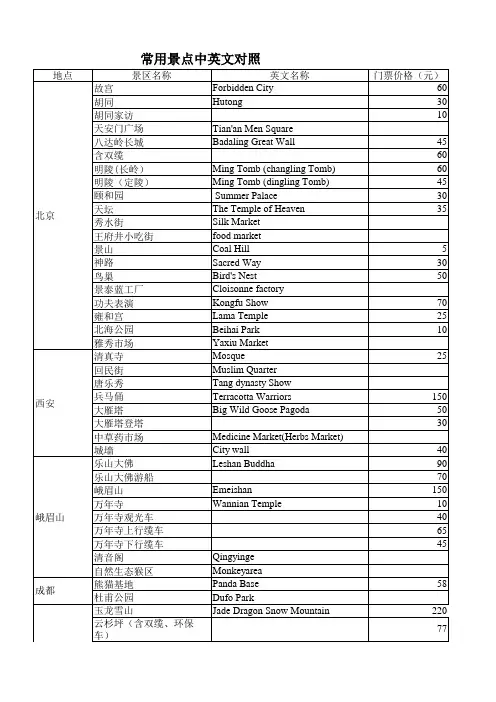
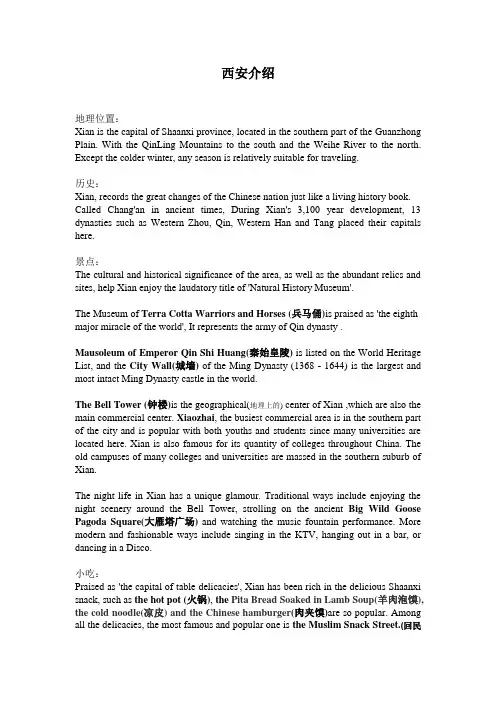
西安介绍 地理位置: Xian is the capital of Shaanxi province, located in the southern part of the Guanzhong Plain. With the QinLing Mountains to the south and the Weihe River to the north. Except the colder winter, any season is relatively suitable for traveling.
历史: Xian, records the great changes of the Chinese nation just like a living history book. Called Chang'an in ancient times, During Xian's 3,100 year development, 13 dynasties such as Western Zhou, Qin, Western Han and Tang placed their capitals here.
景点: The cultural and historical significance of the area, as well as the abundant relics and sites, help Xian enjoy the laudatory title of 'Natural History Museum'.
The Museum of Terra Cotta Warriors and Horses (兵马俑)is praised as 'the eighth major miracle of the world', It represents the army of Qin dynasty .
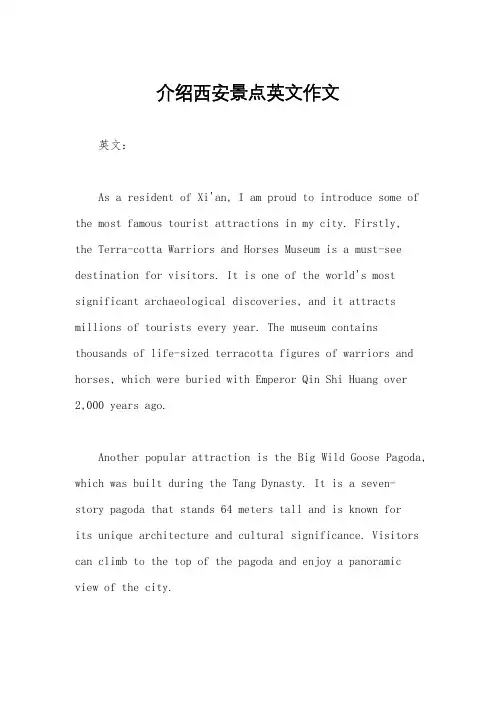
介绍西安景点英文作文英文:As a resident of Xi'an, I am proud to introduce some of the most famous tourist attractions in my city. Firstly,the Terra-cotta Warriors and Horses Museum is a must-see destination for visitors. It is one of the world's most significant archaeological discoveries, and it attracts millions of tourists every year. The museum contains thousands of life-sized terracotta figures of warriors and horses, which were buried with Emperor Qin Shi Huang over 2,000 years ago.Another popular attraction is the Big Wild Goose Pagoda, which was built during the Tang Dynasty. It is a seven-story pagoda that stands 64 meters tall and is known forits unique architecture and cultural significance. Visitors can climb to the top of the pagoda and enjoy a panoramic view of the city.The City Wall is another iconic landmark of Xi'an. It is the most complete city wall that has survived in China, and it offers a glimpse into the city's rich history. Visitors can rent bicycles or take a leisurely stroll along the wall and appreciate the stunning views of the city.In addition to these famous attractions, there are many other interesting places to visit in Xi'an, such as the Shaanxi History Museum, the Muslim Quarter, and the Bell Tower. Each of these attractions has its unique charm and cultural significance.中文:作为一个西安的居民,我很自豪地介绍一些我家乡最著名的旅游景点。
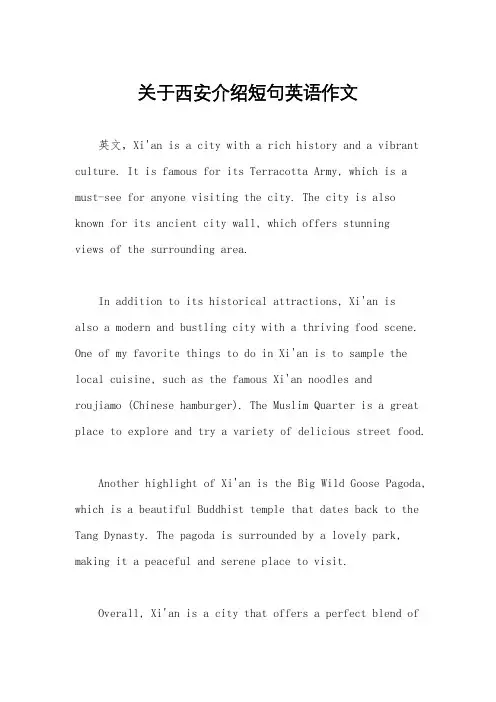
关于西安介绍短句英语作文英文,Xi'an is a city with a rich history and a vibrant culture. It is famous for its Terracotta Army, which is a must-see for anyone visiting the city. The city is also known for its ancient city wall, which offers stunningviews of the surrounding area.In addition to its historical attractions, Xi'an isalso a modern and bustling city with a thriving food scene. One of my favorite things to do in Xi'an is to sample the local cuisine, such as the famous Xi'an noodles androujiamo (Chinese hamburger). The Muslim Quarter is a great place to explore and try a variety of delicious street food.Another highlight of Xi'an is the Big Wild Goose Pagoda, which is a beautiful Buddhist temple that dates back to the Tang Dynasty. The pagoda is surrounded by a lovely park, making it a peaceful and serene place to visit.Overall, Xi'an is a city that offers a perfect blend ofhistory, culture, and modernity. It's a place where you can immerse yourself in ancient traditions while also experiencing the excitement of a dynamic urban center.中文,西安是一个历史悠久、文化丰富的城市。
介绍西安英语作文模板英文回答:Introduction to Xi'an。
Xi'an, the capital of Shaanxi Province, is a historic and culturally vibrant city located in central China. Renowned for its rich history, ancient landmarks, and modern development, Xi'an offers a captivating blend of tradition and modernity.Historical Significance。
Xi'an has been a significant city throughout Chinese history. It served as the capital of the Han and Tang dynasties, two of the most prosperous and influential periods in Chinese civilization. The city is home to numerous historical sites, including:Terracotta Army: An awe-inspiring and iconic UNESCOWorld Heritage Site featuring thousands of life-sized terracotta warriors and horses buried with China's first emperor, Qin Shi Huang.City Wall: A massive and well-preserved ancient fortification that encircled Xi'an during the Ming dynasty, offering panoramic views of the city.Bell Tower: A soaring medieval bell tower located atthe heart of the city, known for its exquisite architecture and symbolic importance.Muslim Quarter: A vibrant and lively neighborhood with a strong Islamic influence, renowned for its traditional markets, mosques, and street food.Cultural Heritage。
关于西安最全的英文翻译钟楼 Bell tower大雁塔 Big wild goose pagoda兵马俑 Emperor Qin's terra-cotta warriors and horses 回民街 HUI minority street经典小吃羊肉泡馍 cruded pancake in mutton soup凉皮 cold rice noodles汤圆 sweet dumpling肉夹馍 chinese hamburger中式早點烧饼Clay oven rolls油条Fried bread stick韭菜盒Fried leek dumplings水饺Boiled dumplings蒸饺Steamed dumplings馒头Steamed buns割包Steamed sandwich饭团Rice and vegetable roll蛋饼Egg cakes皮蛋100-year egg咸鸭蛋Salted duck egg豆浆Soybean milk饭类稀饭Rice porridge白饭Plain white rice油饭Glutinous oil rice糯米饭Glutinous rice卤肉饭Braised pork rice蛋炒饭Fried rice with egg地瓜粥Sweet potato congee面类馄饨面Wonton & noodles刀削面Sliced noodles麻辣面Spicy hot noodles麻酱面Sesame paste noodles鴨肉面Duck with noodles鱔魚面Eel noodles乌龙面Seafood noodles榨菜肉丝面Pork , pickled mustard green noodles 牡蛎细面Oyster thin noodles板条Flat noodles米粉Rice noodles炒米粉Fried rice noodles冬粉Green bean noodle汤类鱼丸汤Fish ball soup貢丸汤Meat ball soup蛋花汤Egg & vegetable soup蛤蜊汤Clams soup牡蛎汤Oyster soup紫菜汤Seaweed soup酸辣汤Sweet & sour soup馄饨汤Wonton soup猪肠汤Pork intestine soup 甜点爱玉Vegetarian gelatin糖葫芦Tomatoes on sticks长寿桃Longevity Peaches芝麻球Glutinous rice sesame balls麻花Hemp flowers双胞胎Horse hooves绵绵冰Mein mein ice麦角冰Oatmeal ice地瓜冰Sweet potato ice紅豆牛奶冰Red bean with milk ice八宝冰Eight treasures ice豆花Tofu pudding甘蔗汁Sugar cane juice酸梅汁Plum juice杨桃汁Star fruit juice青草茶Herb juice点心牡蛎煎Oyster omelet臭豆腐Stinky tofu (Smelly tofu) 油豆腐Oily bean curd麻辣豆腐Spicy hot bean curd虾片Prawn cracker虾球Shrimp balls春卷Spring rolls蛋卷Chicken rolls碗糕Salty rice pudding筒仔米糕Rice tube pudding红豆糕Red bean cake绿豆糕Bean paste cake糯米糕Glutinous rice cakes萝卜糕Fried white radish patty 芋头糕Taro cake肉圆Taiwanese Meatballs水晶饺Pyramid dumplings肉丸Rice-meat dumplings豆干Dried tofu其他当归鸭Angelica duck槟榔Betel nut火锅Hot pot肉羹汤Pork thick soup鱿鱼汤Squid soup花枝羹Squid thick soup。
西安景点英文作文翻译英文:When it comes to tourist attractions in Xi'an, there are plenty of options to choose from. As a resident ofXi'an, I have visited many of these attractions and can offer some insight into the must-see spots.First and foremost, the Terracotta Warriors are a must-visit attraction. This UNESCO World Heritage Site is home to thousands of life-sized terracotta soldiers, horses, and chariots that were buried with Emperor Qin Shi Huang in the 3rd century BC. It's truly a remarkable sight to see and a testament to the incredible craftsmanship of the ancient Chinese.Another popular attraction in Xi'an is the City Wall. This ancient wall dates back to the Ming Dynasty and encircles the entire city. Visitors can walk or bike along the top of the wall and take in stunning views of the cityand its surroundings.For those interested in history and religion, the Great Mosque of Xi'an is a must-visit destination. This mosque, which dates back to the Tang Dynasty, is one of the oldest and largest in China. Its unique blend of Chinese and Islamic architectural styles makes it a fascinating sight to see.Finally, for those looking for a bit of nightlife, the Muslim Quarter is a great place to visit. This bustling area is home to a wide variety of street food vendors, shops, and entertainment options. It's a great place to grab a bite to eat and experience the local culture.中文:说到西安的旅游景点,有很多选择。
Moslem StreeMoslem Street (Huimin Jie) Just as its name implies, Moslem Street is the hub of the Moslem community in Xian City, Shaanxi Province. Located beside the Drum Tower, it is about 500 meters long from south to north. This street is paved with dark colored stone with green trees providing heavy shade during summer; the buildings on both sides of the street are modeled on the styles of both the Ming and the Qing Dynasties. Some of the constructions are restaurants; while others are stores. But here there is one thing in common: the owners are all Moslems.Walking along this twisted, narrow street which is aligned with stores on both sides, you can see that Moslem men with white hats sit inside the stores and talk leisurely with each other. In front of the doors of some stores, old men with white beards sit on the cane chairs enjoying the tender touch of the sun and having fun with the little children running along the street. The main goods of these stores are authentic hand-making Moslem food which tastes very good. While still there are small stores selling the special local products of Shaanxi Province and yet others provide you with exquisite souvenirs.It is stated that once you have been to Moslem Street, you won't feel regretted for the snacks of Xian. Yang Rou Pao Mo is a very distinctive snack of Xian, and is extremely delicious. Fried rice with pickled Chinese cabbage and little capsicum is extremely savoury. And it is a real enjoyment for you to eat it on a hot summer's day. Roast beef, mutton or lamb is another snack that can make your mouth water. After roasting on fire with some flavorings on the meat, it is ready for you to enjoy. While the most famous snack on this street is the steamed stuffed bun of Jiasan. The main ingredients of the steamed stuffed bun here are beef or mutton mixed with the soup decocted from the bones of sheep or cattle.There are also fruit pies made with persimmon here which are considered as the unique refreshment in Xian. These pies take the bright red, glittering and translucent persimmons from the Lintong District of Xian City, Shaanxi Province as the basic ingredients. When making the pies, firstly people will get rid of the skin of the persimmons, pounding the flesh, mixing it with flour, then putting the sweet-scented osmanthus and white sugar inside as the stuffing, then frying them in oil until they are cooked. When eating them, you will feel savory, sweet and soft.There are also a great many other snacks to be found along this street, such as preserved meat, casserole, various noodles, and so on. They are waiting for you to enjoyThe Great Mosque at Huajue LaneThe Mosque is a major spot for religious activities of over 60.000 Moslems in Xi'an, likewise, an important cultural relic protected by the Provincial People‘s Government. Unlike the Arabic mosques, with splendid domes, the minarets reaching into the clouds, the coulourful engraved sketches with dazzling patterns, the Mosque here in Xi'an possesses much Chinese traditional touch in both its design and artistic outlook; besides the style peculiar to Islamic mosques, this Mosque also holds characteristics of Chinese pavilions with painted beams and engraved ridgepoles.However, any further discussion about the Mosque will be futile unless anything of the introduction of Islam into China is brought up.Islam as a religious order was founded in the early period of the 7th century A.D. and was introduced to China in the mid-600s. At that time, Arabian merchants and travelers came to the northwest of China by way of Persia and Afghanistan and thus established diplomatic, trade, and military contacts with China. In the meantime, another route saw a batch of sea voyagers through Bangladesh Bay and the Malacca Strait to China's Guangzhou, Quanzhou, Huangzhou, Yangzhou and other cities where many of them settled down and married the local women who later gave birth to babies who then became Moslems.However, massive immigration of the Moslems to China did not take place until as late as the early period of the 13th century, when Genghis Khan, as a result of his expedition against the west, had conquered vast expanses of land stretching from Central Asia to Eastern Europe, including the north of Iran. Many of the Moslems in the conquered areas were thus forced to enlist and later settled in China.Among the enlisted many were soldiers, and some were smiths and officials who were called the Hui people in the history books on the Y uan dynasty. The Hui people later followed Kublai Khan down to the south, helping him unifying China and then establish the Yuan dynasty. In the wake of the conquest, Islam spread all over China and mosques began to appear everywhere. In the Yuan dynasty, many Moslems held positions both in the military and civilian organs of the country. And a lot of the Moslems took part in Zhu Yuanzhang's uprising in the early 14th century and made great contributions to the founding of the Ming Dynasty. Therefore, all the emperors of the Dynasty issued mandates to protect Islam, and to set up mosques in praise of the Moslems for their feats. In the early 16th century, Islam predominated Qinghai on the minority nationalities including the Huis, the Uygurs, the Kazaks, the Kirgizes, the Tajiks, the Tartars, the Ozbeks, the Dong Xiangs, the Salars and the Bonans. The Moslems in Xi‘an are mainly the Huis, being a small portion out of the ten million in China.The Mosque at Hua Jue Lane is the largest in Xi'an, and at the same time, it is also one of the earliest built on a comparatively large scale, and well preserved mosques in China.According to “the Stele on the Building of the Mosque”, the mosque is said to be built in the Tang Dynasty. However, the architectural style of the mosque suggests a possible building dating back to the Ming Dynasty. The four courtyards of the mosque cover an area of more than 12,000 square meters, out of which about 4,000 are occupied by various structures. The still intact wooden front memorial gateway of the front yard, built at the turn of the 17th century, with glazed tiles on the top, spectacular corners and upturned eaves, is about 9 metres high, and has a historyof about 360 years. The stone memorial gateway in the center of the second courtyard is flanked with a tail stele on either side with dragons carved on each, recording the repair work ever since the building of the Mosque. On the back of one of the steles are engraved characters by the master calligrapher Mi Fu, “May Buddhism Fill the Universe”, on the other, “Royal -Bestowed”by Dong Qichang, another master of the same art of the Ming dynasty. They are treasures in Chinese calligraphy. At the entrance of the third courtyard is an imperial built hall, where a “month tablet”, showing the calculation of the Hui Calendars in Arabic, is stored. It was compiled by a man in charge of the mosque called Xiao Mining in the early period of the Qing dynasty. A three –storeyed octagonal wooden structure called “Retrospection Tower”also stands in the center of the courtyard, which has the same function as the minaret in Islamic temples in Arabic countries, and which is a place from where orders were sent to call the Moslems to come to worship. Respectively, on the south and north wings of the tower, are a reception chamber and a Scripture Chamber, both elegantly laid out. The five wooden houses, which are called “Water Houses”in the southwest section of the Mosque are the place where the believers bathe themselves before they attend their services. And in side the fourth courtyard th ere is a structure called “the Pavilion of Phoenix”, a place where the worshipers used to wait for the services. The Pavilion, in fact, is a compound structure of three small buildings. The six-gabled structure of the central part, adjoining the two three-gabled buildings on each side looks very much like a flying phoenix, and hence its name. Just at the back of the Pavilion, there is a fishpond, beyond which is a platform occupying an area as large as 700 m2. Across both ends of the platform stands the 1,300 square metered service hall, holding over a thousand worshipers at once. There are over six hundred sunk panels well as the sunk panels, are decorated with patterns of painted trailing plants and Arabic letterings. The imam leads his group of worshipers, while facing in the direction of Mecca, to chant in Koran and to pay their religious homage.The Moslems in China share very much the same customs with their brothers and sisters elsewhere in the world. They worship five times a day: at dawn, at noon, in the afternoon, at dusk, and at night. Female worshipers attend their services in a separated place from their brothers, usually at home. Moslems pay special attention to their health and see that they always wear clean clothes. They are teetotalers not only of wine, but also of pork and animal blood for in Koran pigs have been mentioned four times as being “unclean”. According to Koran, a man can have four wives and women should wear veils when they go out. However, except a few places in Xinjiang, the Chinese practise monogamy and women are veiless when they go out. Upon his death, a Moslem has to be “thoroughly cleaned”(thoroughly bathed), has to be put on “Ke Fan”(to be shrouded with a piece of white cloth) and has to be buried coffinless in the ground, with an imam reciting Scriptures at the funeral.The Chinese constitution promulgates that freedom of religion of each citizen and freedom of preserving or reforming local customs for every nationality are permitted. And of course, the Moslems in China enjoy equal rights with peoples of other nationalities and their religious beliefs and customs are respected everywhere in the country.。